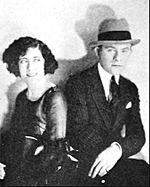Gracie Allen facts for kids
Quick facts for kids
Gracie Allen
|
|
|---|---|
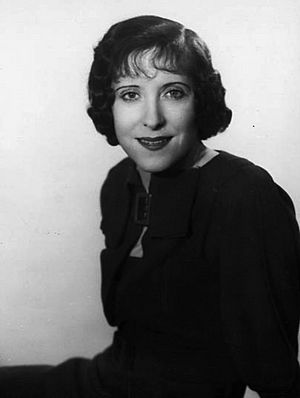
Publicity still of Allen from the Burns and Allen CBS Radio program
|
|
| Born |
Grace Ethel Cecile Rosalie Allen
July 26, 1895 San Francisco, California, U.S.
|
| Died | August 27, 1964 (aged 69) Los Angeles, California, U.S.
|
| Resting place | Forest Lawn Memorial Park, Glendale |
| Occupation | Actress, comedian, vaudevillian |
| Years active | 1924–1958 |
| Spouse(s) | |
| Children | 2, including Ronnie Burns |
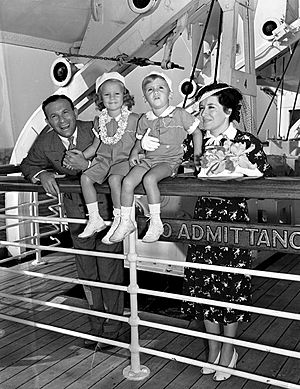
Grace Ethel Cecile Rosalie Allen (born July 26, 1895 – died August 27, 1964) was a famous American actress, comedian, and singer. She became known around the world as the funny partner of her husband, George Burns. They were a comedy team called Burns and Allen. They performed together on radio, television, and in movies.
Gracie Allen received a star on the Hollywood Walk of Fame for her work in television. It is located at 6672 Hollywood Boulevard. In 1988, she and George Burns were added to the Television Hall of Fame. Her co-star, Bea Benaderet, once said Gracie was "probably one of the greatest actresses of our time."
Contents
Early Life of Gracie Allen
Gracie Allen was born in San Francisco, California. Her parents, George and Margaret Allen, were from Ireland. Gracie first appeared on stage when she was only three years old. She got her first radio role from the famous entertainer Eddie Cantor.
In 1914, she finished school at Star of the Sea Convent School. During this time, she became a very good dancer. She soon started performing Irish folk dances with her three sisters. They were known as "The Four Colleens." In 1909, Gracie joined her sister Bessie as a vaudeville performer. Vaudeville was a type of live stage show with many different acts.
In 1922, Gracie met George Burns during a performance. They decided to form a comedy act together. They got married on January 7, 1926, right on stage at the Palace Theatre in Cleveland.
Gracie Allen was born with heterochromia, which means her eyes were different colors. One eye was blue, and the other was green.
When Was Gracie Allen Born?
There is some confusion about Gracie Allen's exact birth date. Some sources say she was born in 1895, 1896, 1902, or 1906. Many public records in San Francisco were destroyed in the earthquake and great fire of April 1906.
Her husband, George Burns, said he didn't know her exact age. However, the date July 26, 1902, is on her death record and crypt marker.
One of Gracie's most famous jokes was about her birth year. She would claim she was born in 1906. Her comedy partner would ask for proof. Gracie would say her birth certificate was destroyed in the earthquake. When her partner pointed out she was born in July and the earthquake was in April, she would just smile and say, "Well, it was an awfully big earthquake."
The most reliable information comes from the U.S. Census taken in 1900. It shows Grace Allen, age four, born in July 1895. This means she was born before 1900. Her high school yearbook also supports this earlier birth year.
Gracie Allen's Comedy Act
When the Burns and Allen act started, Gracie was the "straight man." This meant she would set up George to deliver the funny lines. But George Burns noticed that Gracie's straight lines were getting more laughs than his jokes. So, he cleverly changed the act. He became the straight man, and Gracie became the funny one.
Audiences immediately loved Gracie's character. She was innocent, a little silly, and very naive. The new act, with Gracie as the star, became very popular across the country. They performed in big vaudeville theaters. Many of their famous routines were saved in short films, like Lambchops (1929).
George Burns gave Gracie all the credit for their early success. He once said about their act, "All I had to do was say, 'Gracie, how's your brother?' and she talked for 38 years. And sometimes I didn't even have to remember to say 'Gracie, how's your brother?'"
Gracie Allen on the Radio
In the early 1930s, like many stars, Burns and Allen moved to radio. Their first radio show was similar to their vaudeville act. But George realized they were getting older for that type of humor.
In 1941, he changed the show to a "situation comedy." This is the type of show they are best remembered for. They played themselves, a married show business couple. They dealt with everyday problems caused by Gracie's funny and "illogical logic." Their neighbors, Harry and Blanche Morton, and their announcer, Bill Goodwin (later Harry von Zell), often helped them.
Gracie Allen's Publicity Stunts
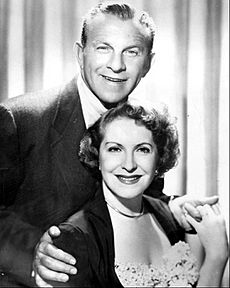
Burns and Allen often used funny tricks to get attention. From 1932 to 1933, they did a very successful stunt. They pretended Gracie's brother was missing for a whole year! They would pop up on other radio shows and ask if anyone had seen him. However, Gracie's real brother didn't find it funny and asked them to stop. He even disappeared from public view because the joke was so popular.
In 1940, Gracie Allen announced she was running for president of the United States. She ran on the "Surprise Party" ticket. Burns and Allen traveled across the country on a special train, performing their radio show live in different cities.
In one of her campaign speeches, Gracie said, "I don't know much about the Lend-Lease Bill, but if we owe it we should pay it." Another funny line was: "Everybody knows a woman is better than a man when it comes to introducing bills into the house." The Surprise Party's symbol was a kangaroo, and their motto was "It's in the bag." As part of the joke, a book called How to Become President by Gracie Allen was published. Harvard University even endorsed Gracie!
Gracie Allen was also the main character in a detective novel called The Gracie Allen Murder Case by S. S. Van Dine. Gracie joked, "S.S. Van Dine is silly to spend six months writing a novel when you can buy one for $2.95."
In another stunt, Gracie played a piano concerto at the Hollywood Bowl and later at Carnegie Hall. Their staff hired someone to write a joke piece called the "Concerto for Index Finger." The orchestra would play wildly, then stop for Gracie to play a one-finger scale with one wrong note. The orchestra would then play music based on that wrong note. Finally, Gracie would hit the right note, and the whole orchestra would applaud. A professional pianist actually played the notes offstage. This concerto was even shown in the film Two Girls and a Sailor (1944).
Gracie Allen's Films
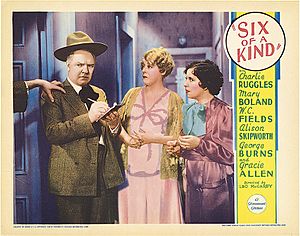
In the early 1930s, Burns and Allen appeared in several short films. They performed some of their classic comedy routines. They also starred in two full-length movies with the famous comedian W. C. Fields: International House (1933) and Six of a Kind (1934).
Burns and Allen were also in three "Big Broadcast" movies: The Big Broadcast (1932) with Bing Crosby, The Big Broadcast of 1936 (1935) with Crosby, and The Big Broadcast of 1937 (1936) with Jack Benny. They also appeared in We're Not Dressing (1934).
In 1937, Burns and Allen starred with Fred Astaire in A Damsel in Distress. This was a musical with songs by George Gershwin. It was Astaire's first film without his dancing partner, Ginger Rogers. Astaire's co-star, Joan Fontaine, was not a dancer. He felt the movie needed more comedy.
Burns and Allen had both been dancers in vaudeville. When they heard about the movie, they called Astaire. They practiced a complicated dance routine using small whisk brooms. Astaire loved it so much that he learned it, and they all danced it together in the film. They also danced with Astaire in a challenging scene in a funhouse with distorted mirrors.
Their next film was College Swing (1938). Burns and Allen were the top stars, along with Martha Raye and Bob Hope. They also had a great supporting cast.
A lively musical comedy called Honolulu (1939) came next. It starred Eleanor Powell, Robert Young, and Burns and Allen. In this movie, Gracie and George performed separately for most of the film. Gracie even sang and danced the energetic title song with Eleanor Powell.
In the same year, Gracie's popularity was so high that S.S. Van Dine wrote a detective novel featuring her. It was called The Gracie Allen Murder Case. This funny book was made into a movie, also titled The Gracie Allen Murder Case (1939). Gracie was the main star, without George Burns. The movie was so successful that Gracie was cast in another similar mystery-comedy film two years later. It was called Mr. and Mrs. North (1942). In this film, she was the top-billed comedic detective, again without George.
Gracie Allen's last movie appearance was a musical cameo in Two Girls and a Sailor. She played a funny concert pianist, again without George Burns. She then continued her career in radio and later moved to television with her husband.
Gracie Allen on Television
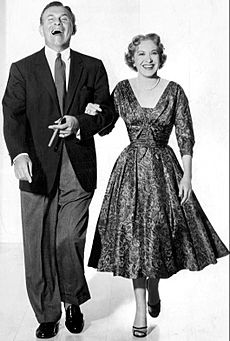
In 1949, Burns and Allen joined CBS. Their friend Jack Benny had already moved to CBS. The head of CBS, William S. Paley, believed that talented stars, not the network, made the difference. Benny convinced Burns and Allen to join him.
The Burns and Allen radio show became part of the CBS lineup. A year later, in 1950, they brought their show to television as The George Burns and Gracie Allen Show. They continued to use the same successful format from their radio days. They played themselves as television stars, still living next door to Harry and Blanche Morton. At the end of each show, they would perform a short, funny dialogue, just like their old vaudeville routines.
Gracie Allen retired in 1958. George Burns tried to continue the show without her. It was renamed The George Burns Show. The setting changed from their home to George's office. Blanche, their neighbor, became George's secretary to help Gracie keep an eye on him. But the show only lasted about a year without Gracie.
"Say Good Night, Gracie"
At the end of their vaudeville, radio, and television shows, George Burns would look at Gracie and say, "Say good night, Gracie." She would usually just reply, "Good night." There's a popular story that she would say, "Good night, Gracie." However, recordings of their shows and books about old-time radio confirm she never actually said "Good night, Gracie."
Gracie Allen's Private Life

In the 1930s, Burns and Allen adopted two children, Sandra Jean and Ronald Jon. They had found out they couldn't have children of their own. They decided to raise their children as Catholics and let them choose their own religion as adults. Ronnie later joined the cast of his parents' television show. He played their son, a serious drama student who didn't like comedy. Sandy only appeared on the show sometimes, usually as a telephone operator or waitress. She later left show business to become a teacher.
As a child, Gracie Allen had been badly burned on one arm. She was very sensitive about the scars. Throughout her life, she wore long or three-quarter length sleeves to hide them. This style became her trademark.
Gracie was also said to be sensitive about having one green eye and one blue eye (heterochromia). Some people thought she retired because they were planning to film the eighth season of The Burns & Allen Show in color. However, this is unlikely because a color episode was filmed and broadcast in 1954. Gracie Allen retired in 1958 due to health reasons. George Burns often said that she continued with the TV show for as long as she did just to make him happy, even though she had health problems.
Gracie Allen's Death
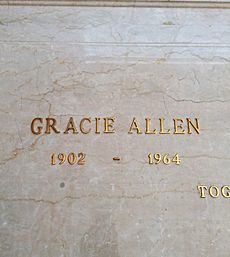
Gracie Allen had a history of heart disease. She died from a heart attack in Hollywood on August 27, 1964. She was 69 years old, according to census records. She was buried in a crypt at the Freedom Mausoleum in the Sanctuary of Heritage at Forest Lawn Memorial Park, Glendale, California.
George Burns was buried next to her in 1996 when he died at the age of 100. The marker on their crypt was changed to "Gracie Allen (1895–1964) and George Burns (1896–1996)—Together Again."
Gracie Allen's Filmography
- Lambchops (1929; short) as Gracie the Girlfriend
- The Big Broadcast (1932; first feature film) as Gracie
- International House (1933) as Nurse Allen
- College Humor (1933) as Herself
- Six of a Kind (1934) as Gracie Devore
- We're Not Dressing (1934) as Gracie
- Many Happy Returns (1934, first leading role) as Herself
- Love in Bloom (1935) as Gracie Downey
- Here Comes Cookie (1935) as Herself
- The Big Broadcast of 1936 (1935) as Herself
- The Big Broadcast of 1937 (1936) as Mrs. Platt
- College Holiday (1936) as Calliope 'Gracie' Dove
- A Damsel in Distress (1937) as Gracie
- College Swing (1938) as Gracie Alden
- Honolulu (1939) as Millie De Grasse
- The Gracie Allen Murder Case (1939; without George Burns – a "Philo Vance" mystery by S. S. Van Dine) as Herself
- Mr. and Mrs. North (1941; second murder mystery film without Burns) as Pamela North
- Two Girls and a Sailor (1944, guest appearance without Burns; last movie role) as Herself
Gracie Allen's Radio Series
- The Robert Burns Panatella Show: 1932–1933, CBS
- The White Owl Program: 1933–1934, CBS
- The Adventures of Gracie: 1934–1935, CBS
- The Campbell's Tomato Juice Program: 1935–1937, CBS
- The Grape Nuts Program: 1937–1938, NBC
- The Chesterfield Program: 1938–1939, CBS
- The Hinds Honey and Almond Cream Program: 1939–1940, CBS
- The Hormel Program: 1940–1941, NBC
- The Swan Soap Show: 1941–1945, NBC, CBS
- Maxwell House Coffee Time: 1945–1949, NBC
- The Amm-i-Dent Toothpaste Show: 1949–1950, CBS
The Gracie Award
The Gracie Award is given by the Alliance for Women in Media. It honors excellent programs created by women, for women, and about women. These programs can be on radio, television, cable, or online. The awards encourage a realistic and varied picture of women in entertainment, news, and other shows. Gracie Allen has been nominated twice for the National Women's Hall of Fame. James L. Brooks named his company, Gracie Films, after her.
See also
 In Spanish: Gracie Allen para niños
In Spanish: Gracie Allen para niños
- The George Burns and Gracie Allen Show, 1950–58, CBS


